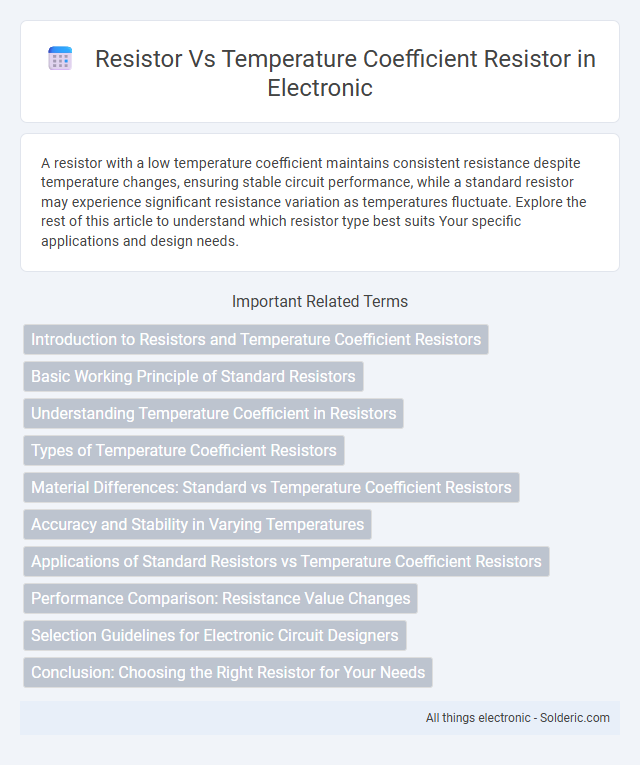A resistor with a low temperature coefficient maintains consistent resistance despite temperature changes, ensuring stable circuit performance, while a standard resistor may experience significant resistance variation as temperatures fluctuate. Explore the rest of this article to understand which resistor type best suits Your specific applications and design needs.
Comparison Table
| Feature | Resistor | Temperature Coefficient Resistor (TCR Resistor) |
|---|---|---|
| Purpose | Limits current, divides voltage, and dissipates power in circuits | Maintains stable resistance over temperature changes |
| Temperature Coefficient | Varies, typically +-100 ppm/degC or higher | Low TCR, typically < +-10 ppm/degC for precision applications |
| Material | Carbon film, metal film, wire-wound, thick/thin film | Special alloys or metal film with controlled TCR characteristics |
| Applications | General-purpose circuits, power supplies, signal conditioning | Precision analog circuits, temperature-sensitive measurements, sensors |
| Cost | Lower cost, widely available | Higher cost due to tighter specifications |
| Accuracy | Standard accuracy (+-1% to +-5%) | High accuracy (+-0.1% or better) |
Introduction to Resistors and Temperature Coefficient Resistors
Resistors regulate electrical current by providing a fixed resistance, crucial for circuit functionality and stability. Temperature coefficient resistors are specialized components designed to minimize resistance variations caused by temperature changes, maintaining performance consistency under varying thermal conditions. Your choice of resistor impacts circuit precision, especially in environments with fluctuating temperatures where temperature coefficient resistors enhance reliability.
Basic Working Principle of Standard Resistors
Standard resistors operate by providing a fixed electrical resistance, restricting current flow according to Ohm's law. They are typically made from materials like carbon film, metal film, or wire wound to ensure consistent resistance values under normal conditions. Your choice of resistor impacts circuit stability, especially when temperature variations are a factor, as standard resistors have varying temperature coefficients affecting their resistance with heat changes.
Understanding Temperature Coefficient in Resistors
The temperature coefficient of a resistor quantifies how its resistance changes with temperature, usually expressed in parts per million per degree Celsius (ppm/degC). Standard resistors exhibit varying temperature coefficients based on their materials, with metal film resistors typically offering lower coefficients compared to carbon composition resistors. Precision temperature coefficient resistors are engineered to maintain stable resistance values across temperature fluctuations, crucial for sensitive electronic circuits requiring high accuracy and reliability.
Types of Temperature Coefficient Resistors
Temperature coefficient resistors include Positive Temperature Coefficient (PTC) and Negative Temperature Coefficient (NTC) types, each designed to change resistance predictably with temperature variations. PTC resistors increase resistance as temperature rises, commonly used in overcurrent protection and self-regulating heating elements. NTC resistors decrease resistance with temperature, making them ideal for temperature sensing and compensation applications where precise thermal response is critical.
Material Differences: Standard vs Temperature Coefficient Resistors
Standard resistors are typically made from carbon film, metal film, or wire wound materials, designed for general-purpose applications with moderate tolerance to temperature changes. Temperature coefficient resistors, often constructed from specialized alloys like nickel-chromium or metal oxide, exhibit a precisely controlled resistance variation with temperature, ensuring stability in sensitive circuits. Your choice depends on the need for thermal stability, where temperature coefficient resistors provide superior performance in environments with fluctuating temperatures.
Accuracy and Stability in Varying Temperatures
Resistors with low temperature coefficients, often called precision or temperature coefficient resistors, provide superior accuracy and stability by minimizing resistance changes as temperatures fluctuate. Standard resistors can exhibit significant resistance variation with temperature shifts, leading to potential errors in sensitive circuits. Using a temperature coefficient resistor ensures your electronic components maintain consistent performance and reliability despite environmental temperature changes.
Applications of Standard Resistors vs Temperature Coefficient Resistors
Standard resistors are widely used in general electronic circuits for current limiting, voltage division, and signal conditioning where temperature variations have minimal impact. Temperature coefficient resistors are specifically applied in precision measurement instruments, temperature sensors, and compensation circuits requiring stable resistance values across wide temperature ranges. Their low thermal drift makes them essential in aerospace, automotive, and industrial control systems demanding high accuracy and reliability.
Performance Comparison: Resistance Value Changes
Resistor vs temperature coefficient resistor performance significantly differs in resistance value stability as temperature varies. Standard resistors typically experience larger resistance fluctuations with temperature changes, often measured by their temperature coefficient of resistance (TCR) in parts per million per degree Celsius (ppm/degC). Your choice of a low TCR resistor ensures minimal resistance drift, enhancing circuit reliability in environments with temperature variations.
Selection Guidelines for Electronic Circuit Designers
When selecting resistors for electronic circuits, designers must prioritize temperature coefficient to ensure stability and accuracy under varying thermal conditions. Precision resistors with low temperature coefficients, typically measured in parts per million per degree Celsius (ppm/degC), provide minimal resistance change, crucial for sensitive analog and measurement applications. Standard resistors with higher temperature coefficients may suffice for general-purpose uses where thermal variation impact is less critical.
Conclusion: Choosing the Right Resistor for Your Needs
Selecting the right resistor depends on your specific application requirements, particularly regarding temperature stability. Standard resistors exhibit varying resistance values as temperature changes, while temperature coefficient resistors (TCR) are designed to minimize this variation, offering enhanced precision. For circuits demanding high accuracy and consistent performance under thermal fluctuations, a low-TCR resistor is the optimal choice to ensure reliable operation.
resistor vs temperature coefficient resistor Infographic

 solderic.com
solderic.com